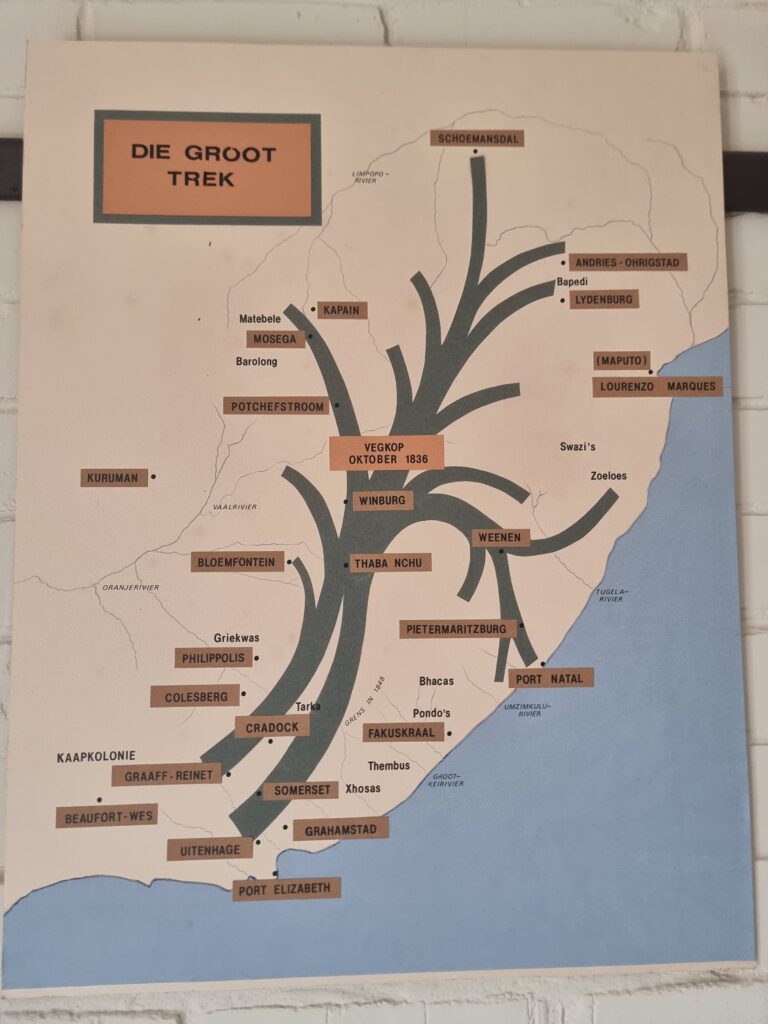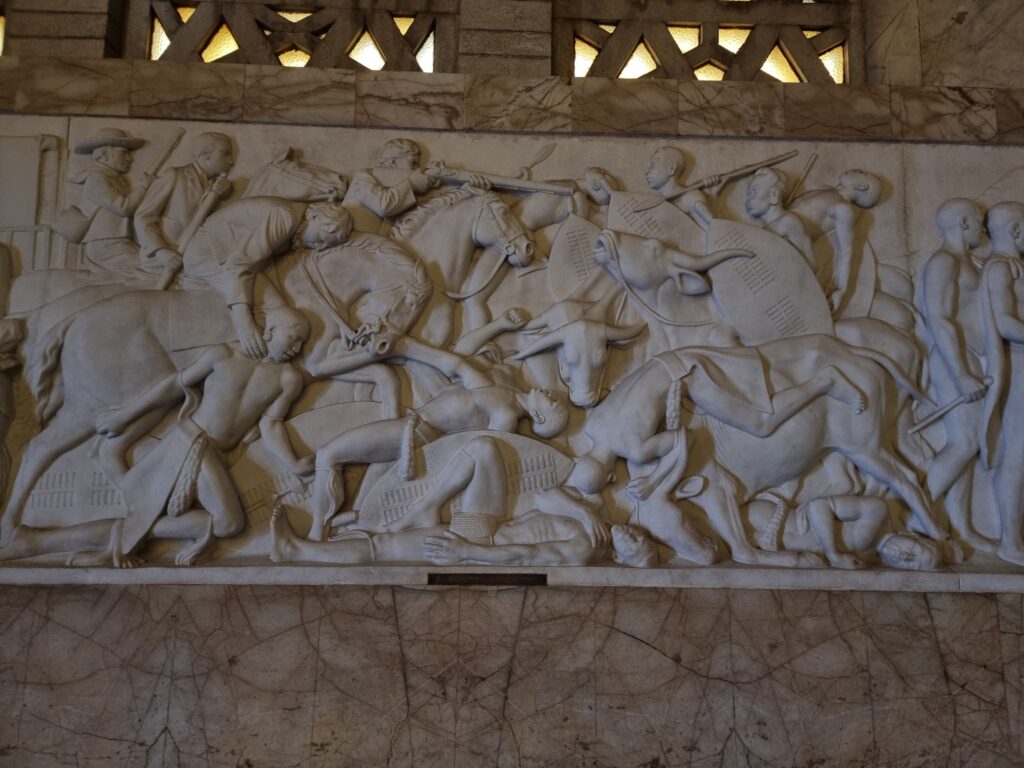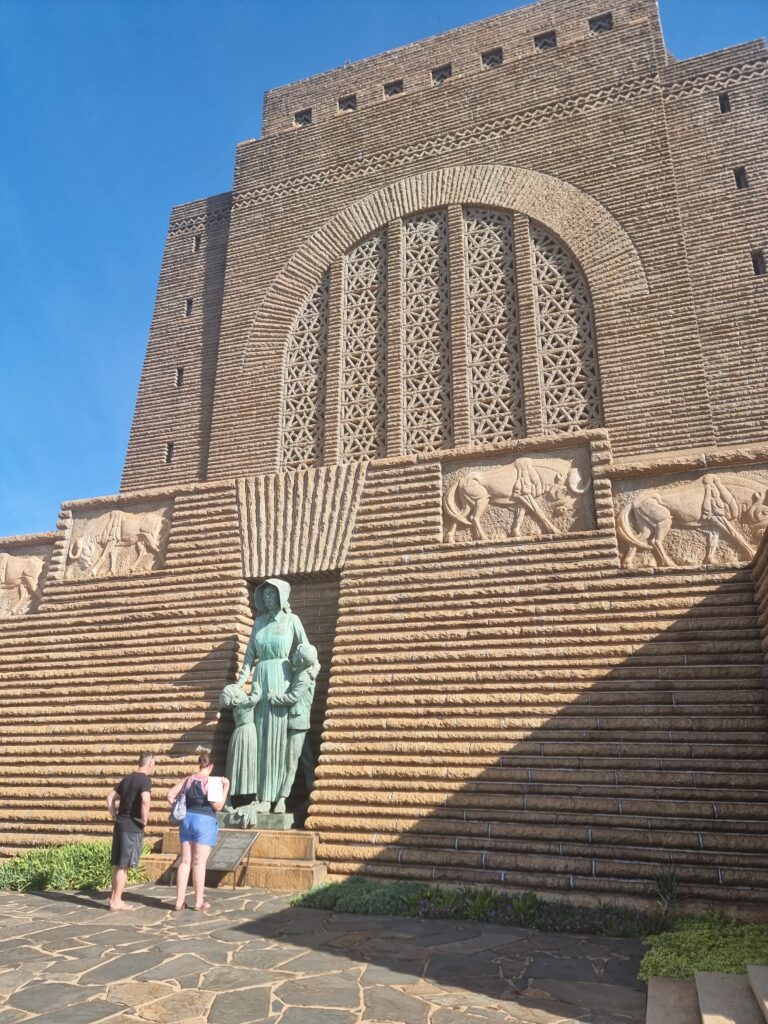
Discovering the Voortrekker Monument: A Journey Through South Africa’s History
My first visit to the Voortrekker Monument was an eye-opener, and it sparked a deep interest in South Africa’s history that I never quite expected. Since that visit, I’ve been back a few times, and each time, I uncover something new—another layer of understanding about the land we live on, the people who shaped it, and the stories that have been passed down through generations.
One of the things that struck me as I delved deeper into the history of the Voortrekkers is how the names of significant places in South Africa suddenly made sense. Places like Pietermaritzburg, Pretoria, Louis Trichardt, Krugersdorp, and names of roads like Jan Smuts or Hendrick Potgieter. These aren’t just names on a map; they’re named after the very leaders who embarked on the Great Trek. These figures—Piet Retief, Andries Pretorius, Louis Tregardt, Paul Kruger, and Jan Smuts—became real to me, their stories etched into the landscape of South Africa.
The Eastern Cape: The Starting Point of the Great Trek
Before the Voortrekkers set out on their epic journey, life in the Eastern Cape was tough. British colonial rule was increasingly restrictive, and many of the Dutch-speaking settlers (the Trekboers) felt marginalized and oppressed. The eastern frontier was a place of constant conflict, not just with the British but also with the local Xhosa people. This tension, combined with the desire for independence and the hope for a better life, led to the decision to embark on the Great Trek—a mass migration into the interior of South Africa.

This wasn’t just a haphazard journey; it was carefully organized. The Voortrekkers formed “Trek Companies,” groups of families and individuals who traveled together, supporting one another through the challenges ahead. There were scouts who would ride ahead, finding the best routes, locating water sources, and identifying safe passages over rivers and around mountains. They often had to cross river drifts, those natural crossings that could be treacherous depending on the season and weather. It was a massive logistical undertaking, and each company had its own leader, but they all shared a common goal—freedom and a new start.
The Marble Frieze: Bringing History to Life
Inside the Voortrekker Monument, one of the most captivating features is the marble frieze that wraps around the walls. As I stood there, taking it all in, it felt like history was coming alive before my eyes. The frieze is over 100 meters long and depicts scenes from the Great Trek in incredible detail. It’s one thing to read about these events in a history book, but seeing them carved into marble made them feel real.

The frieze vividly depicts some of the intense battles fought during the Great Trek. Scenes from the battles at Kapein(Gabeni), Vegkop, Italeni and Weenen, show the desperation and determination of the Voortrekkers as they defended themselves against overwhelming odds. The carvings capture the chaos and fear of these encounters—the clash of weapons, the struggle for survival, and the moments of victory and loss. The battle at Blood River (Ncome), where the Voortrekkers used their wagons to form a laager and fend off the Zulu forces, is depicted with such realism that you can almost feel the tension in the air.
Surrounding the monument, the circular wall with wagons embossed on its surface serves as a powerful reminder of the Battle of Blood River. This wall commemorates the laager formation—a strategic defensive maneuver that was crucial to the Voortrekkers’ survival during their journey. The architecture of the monument, with its towering structure and strong, square base, mirrors the resilience and determination of the Voortrekkers themselves.
The Zulu Encounter: Power, Spears, and Symbolism
As I explored the lower levels of the Voortrekker Monument, I was drawn to the exhibit dedicated to the Zulu people and their encounter with the Voortrekkers. As you reach the end of the building tour, near the bottom shop, the powerful sound of the Usuthu war cry echoes through the hall. It’s an enthralling and somewhat haunting experience that transports you back to a time of intense conflict and cultural encounters.
This section of the exhibit also includes plaques with Zulu names and their meanings, such as “Ugibabanye” (the one who ousts the others), “Izimpohlo” (the unmarried men), “Ihlaba” (they who cause sharp pain), “Udlangezwa” (the one who eats without feeling it), “Isiphezi” (the one who puts an end to things), “Udlambedlu” (the one who eats with fierce impatience), and “Umbonambi” (the bad omen). These names carry deep significance and provide insight into the warrior culture of the Zulu nation during this period.
Another striking feature of the monument is the spear gate at the entrance of the building. The spears represent the power and dominion that the Zulu king had over the lands and territory during that time. This symbolic gate serves as a reminder of the formidable presence of the Zulu nation and the respect they commanded. While this interpretation was shared with me by a knowledgeable tour guide, it stands as a powerful symbol of the authority and strength of the Zulu people that not everyone may notice upon first visit.
The Architecture and Hidden Details of the Monument
The Voortrekker Monument itself is an architectural marvel, and the more I visit, the more I notice the little details that make it so special. Designed by architect Gerard Moerdijk and completed in 1949, the building is filled with symbolic elements that transport you into history. For instance, as you explore the monument, you’ll see buffalo horns sculpted into the stonework—symbols of strength and determination, qualities that defined the Voortrekkers. The shape of the building itself, with its towering structure and solid, square base, mirrors the shape of the wagons that the Voortrekkers used during their journey.

As I wandered through the monument, I began to notice other details, like the intricate patterns on the walls that represent the wheels of ox wagons, and the lanterns that resemble the lights the Voortrekkers would have used at night. Each of these details adds to the experience, making you feel as though you’re walking in the footsteps of history.
One of the most memorable moments for me was walking up the long flight of stairs to the top of the monument. As I reached the top, I was rewarded with an unobstructed view of Pretoria, stretching all the way to the Union Buildings, with the surrounding mountains and hills of the Magaliesberg range framing the scene. It’s a breathtaking panorama that gives you a sense of the strategic importance of Pretoria, nestled in the valley and protected by its natural surroundings.

Exploring the Lower Levels: A Glimpse into the Past
One of the most fascinating parts of the Voortrekker Monument is the lower level, where you can walk through exhibits that bring the past to life. Here, the flags of the old Boer Republics are displayed, a reminder of the different territories that the Voortrekkers helped establish. As you explore further, you’ll find exhibits that showcase the crossing of the Orange River, with large, old-school Bibles on display, reflecting the deep faith that guided the Voortrekkers on their journey.
The lower level also houses a treasure trove of tools and equipment that were essential for day-to-day living. From candle and soap-making tools—using the fat of animals—to the tools used to fix and maintain wagons, farm, and build new lives from scratch, these exhibits reveal the ingenuity and resilience of the Voortrekkers. It’s easy to overlook the sheer amount of work that went into maintaining their way of life, but these displays bring that reality into sharp focus.
One exhibit that left a lasting impression on me was the immersive experience of living inside an ox wagon. As you walk through, you hear the creaking of wood, the sounds of animals, and the wind rustling through the trees—creating an atmosphere that transports you back to the outback. It’s a haunting reminder of the hardships the Voortrekkers faced and how they had to survive in the wilderness with only their wagons and each other for support. Today, the closest experience we have to this is camping, but it’s clear that what the Voortrekkers endured was on an entirely different level.
Walking the Trek Route in the Voortrekker Garden
Outside the monument, the Voortrekker Garden offers a different kind of experience. The garden is designed to replicate the route of the Great Trek, allowing visitors to walk the same path—from Graaff-Reinet in the Eastern Cape, all the way up to the Limpopo River in the north, and down into Natal. It’s an incredible way to get a sense of the scale of the journey these people undertook.

As I walked through the garden, following the path of the Trek, I couldn’t help but feel a deep sense of connection to the past. The garden isn’t just a collection of plants and pathways—it’s a living map of the Voortrekkers’ journey. Along the way, I discovered small gems of history, learning about towns like Schoemansdal, Potchefstroom, and many others that were established during and after the Great Trek.
One story that stood out to me was that of the “kaalvoetmeisie”—Susanna Smit, who reportedly said she would rather walk barefoot over the Drakensberg mountains again than be ruled by the British. This statement captures the sheer determination and resolve of the Voortrekkers, who were willing to endure incredible hardships in pursuit of their freedom.

The garden also features an exhibit of the kraal of Dingaan, providing a glimpse into the cultural and political dynamics of the time. Nearby, a life-sized elephant sculpture stands as a powerful symbol of the respect that elephants command in Zulu culture. The Zulu refer to their king as “Indlovu,” meaning “The Elephant,” a title that reflects the king’s power and stature, much like the animal itself.
The Intensity and Desperation of Battle
The history of the Great Trek is filled with intense and desperate battles, where survival was never guaranteed. The battles of Italeni, Gabeni, Weenen, and Bloukrans stand out as moments of incredible hardship and resilience. At Bloukrans, for instance, the Voortrekkers were attacked in the dead of night by Zulu forces, resulting in a tragic loss of life. Yet, out of these harrowing experiences, heroes emerged—men, women, and even children who found the strength to fight on, even when all hope seemed lost.

Women played a crucial role in these moments of despair, often boosting the morale of the men when they were ready to give up. Their determination and courage were vital to keeping the fighting spirit alive, ensuring that the Voortrekkers could continue their journey despite the overwhelming odds against them.
An Ongoing Journey of Discovery
Even though I’ve visited the Voortrekker Monument 17 times now, I still feel like there’s so much more to learn. Every time I go, I discover something new—another detail in the frieze, another piece of history that adds to the bigger picture. The monument has become a place of reflection for me, a place where I can connect with South Africa’s past in a very real and personal way.
For anyone who hasn’t visited yet, I can’t recommend it enough. The Voortrekker Monument isn’t just a tribute to the past; it’s a place where history comes alive, where you can walk in the footsteps of those who came before us, and where you can gain a deeper understanding of the complex and fascinating history of our country. Budget a whole day to explore, because there’s so much to take in, from the exhibits to the panoramic views at the top. This spectacular place holds some of the most well-preserved history in South Africa, and it would be a shame to miss it.








